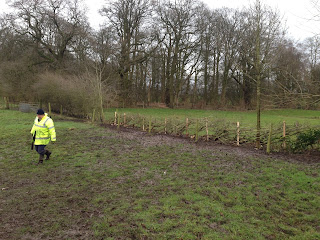This was our third visit of the year to this hedge, and the last time before spring replaces bare branches and dormant sap with leaves, growth and nesting birds. The end of the winter’s hedgelaying had a sting in the tail, in the form of a very wet worksite to rival (and occasionally out-soak) the nearby and notorious hedge of January 2016. 11 volunteers remained undaunted by the conditions and the potential for rain later.
 |
| The hedge before ... |
The corner of the field we were working in didn’t look too wet, but the last few yards around the hedge were sodden, including one nasty dip hidden under the water, where Neil very nearly overtopped his wellies when he stepped in it. Nevertheless, we soon got cracking on several sections of hedge, while Neil, Adrian, David and Andy started the fire.
Lisa had been drawn to the workday not so much by the prospect of laying hedges, but by talk of some very friendly sheep in the area who might come up to say hello. She fed us some marvellous chocolate brownies for morning break, and then went off in the direction of the flock, which was scattered across the far side of the field. Sadly, the sheep showed little interest in saying hello.
 |
| The fire, with DIY brick damper |
The hedge moved on apace, with the area becoming wetter and wetter, and muddier and muddier. However, the fire was slowly growing, with early difficulties in the wind having been overcome by using some bricks to make a damper. By lunchtime, there was enough warmth to offset the cold of the wind.
 |
| The hedge after ... |
After lunch, the separate sections of laid hedge were all joined together, and we could see just how much progress was made. And after a couple more failed attempts to entice the sheep to come closer, Lisa was finally rewarded at home time when some friendly noises and a handful of grass coaxed one sheep to come over the be stroked (and to try nibbling our wellies). Lisa has wanted to hug a sheep ever since she was a child. MNTV makes people’s dreams come true!
 |
| A slightly informal group photo |
 |
| Look how much happiness you can get from conservation (ok, hugging a sheep) |





